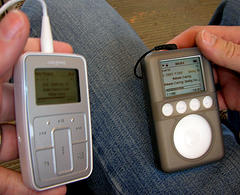
Here are four podcasts we recorded for the first annual Open Access day on October 14.
https://circle.ubc.ca/handle/2429/2689//browse-title
See all our Science and Engineering podcasts here
** Photo by andyi.

Here are four podcasts we recorded for the first annual Open Access day on October 14.
https://circle.ubc.ca/handle/2429/2689//browse-title
See all our Science and Engineering podcasts here
** Photo by andyi.
Dr. William R. Cullen from UBC’s Department of Chemistry has authored a fascinating book dealing with that most interesting of compounds – arsenic.
For a detailed blurb and table of contents of Is Arsenic an Aphrodisiac?, go to the Royal Society of Chemistry.
Is Arsenic an Aphrodisiac? is available in the UBC Library at the following Call Number.
A search of the Scifinder Scholar database reveals 393 papers written by Dr. Cullen with the earliest paper dealing with arsenic compounds published in a 1959 issue of the Journal of the Chemical Society.
Searching the Web of Science database for Cullen, WR and then sorting for most cited reveals that the article Arsenic Speciation in the Environment published by Cullen and Reimer in volume 89 of Chemical Reviews has been cited a cool 924 times.
Submitted by Kevin Lindstrom Liaison Librarian for Chemistry UBC-Vancouver
As a follow-up to this post, based upon 269 published articles Dr. Cullen’s h-index is 45.
A new single gateway to NRC research is on the way. Following an NRC CISTI pilot project with seven NRC institutes, NRC has given the go-ahead to create an NRC Publications Archive (NPArC) that will provide access to NRC’s record of science and demonstrate the many ways NRC researchers translate science and technology into value for Canada.
This searchable, web-based repository will increase the access to NRC authored publications, guarantee long-term access to NRC’s research output, and serve as a valuable resource for NRC researchers, collaborators and the public. NRC-CISTI will manage and maintain NPArC.
As part of this initiative, NRC has established a policy making it mandatory, starting in January 2009, for NRC institutes to deposit copies of all peerreviewed, NRC-authored publications and technical reports in NPArC.
Wherever possible, NPArC will provide access to the full text of these publications. NRC’s Licence to Publish (Crown Copyright) will be updated to declare its intent to deposit the full-text of NRC-authored publications in NPArC. However, the nature, timing and extent of access to individual publications depends on a variety of factors, including agreements with publishers, or in the case of technical reports the sensitivity or confidentiality of content.
More information about the NRC Publications Archive will be available closer to the launch date in December 2008.
Source: CISTI News September 2008
Posted by Kevin Lindstrom Physical Sciences and Engineering Librarian

An article by Kevin and I has just been published early this week. It is free open access, please feel free to read and forward it to your colleagues:
Barsky E., & Lindstrom K. Podcasting the Sciences: A Practical Overview. Issues in Science and Technology Librarianship, Fall 2008.
Abstract:
University science education has been undergoing great amount of change since the commercialization of the Internet a decade ago. Mobile technologies in science education can encompass more than the proximal teaching and learning environment. Podcasting, for example, allows audio content from user-selected feeds to be automatically downloaded to one’s computer as it becomes available online, and then later transferred to a portable player for the user’s consumption at a convenient time and place. Enjoying a phenomenal growth in mainstream society, podcasting is asynchronous and could be provided at a distance from a classroom. This paper reports a case study from the University of British Columbia that implemented podcasting for physics content. It presents the rationale for, technical details, and step-by-step guide to creating podcasts in the sciences.
** Photo by Josh Bancroft
Researchers from the Departments of Geography and Earth and Ocean Sciences have used the Celebration of Light Fireworks Competition as an opportunity to model plume trajectory, plume height and spread, and vertical dispersion.
Lidar ceilometer observations and modeling of a fireworks plume in Vancouver, British Columbia. Atmospheric Environment, Volume 42, Issue 30, September 2008, Pages 7174-7178 Derek van der Kamp, Ian McKendry, May Wong, Roland Stull.
Abstract
Observations of a plume emanating from a 30-min duration pyrotechnic display with a lidar ceilometer are described for an urban setting in complex, coastal terrain. Advection of the plume across the ceilometer occurred at a mean height of 250 m AGL. The plume traveled downwind at approx 3 m/s, and at a distance of 8 km downwind, was approx 100 m in vertical thickness with particulate matter (PM) concentrations of order 30–40 mg/m^3. Surface PM observations from surrounding urban monitoring stations suggest that the plume was not mixed to ground over the urban area. Plume trajectories at approx 250 m simulated by three numerical models all traveled to the northeast of the ceilometer location. Horizontal plume dispersion estimates suggest that the model trajectories were too far north to accommodate the likely lateral plume spread necessary to explain the ceilometer observations. This poor agreement between near surface observations and model output is consistent with previous mesoscale model validations in this region of complex urbanized terrain, and suggests that despite improvements in mesoscale model resolution, there remains an urgent need to improve upstream initial conditions over the Pacific Ocean, data assimilation over complex terrain, the representation of urban areas in mesoscale models, and to further validate such models for nocturnal applications in complex settings.
Submitted by Kevin Lindstrom Liaison Librarian for Physical Geography and Earth and Ocean Sciences

A major new global prize celebrating the work of both professional and amateur photographers has been awarded in Paris.
The Prix Pictet is the first competition of its type to focus on the global issue of ‘sustainability’ – and, this year in particular, on water.
The winner of 100,000 Swiss francs (£53,000) is the Canadian photographer Benoit Aquim.
Here is the BBC audioshow with the celebrated works – http://news.bbc.co.uk/2/hi/entertainment/7700551.stm
** Photo by visualpanic
In an article published in October’s Journal of Atmospheric and Oceanic Technology a group of researchers from Japan describe the instrumentation installed on Boeing 747 and Boeing 777 aircraft used for measuring atmospheric CO2.
Machida, T., H. Matsueda, Y. Sawa, Y. Nakagawa, K. Hirotani, N. Kondo, K. Goto, T. Nakazawa, K. Ishikawa, and T. Ogawa, 2008: Worldwide Measurements of Atmospheric CO2 and Other Trace Gas Species Using Commercial Airlines. Journal of Atmospheric and Oceanic Technology. volume 25 issue 10, 1744–1754.
Article Abstract
New automated observation systems for use in passenger aircraft to measure atmospheric carbon dioxide (CO2) and other trace species have been developed and are described in this paper. The Continuous CO2 Measuring Equipment (CME) is composed mainly of a nondispersive infrared analyzer, a datalogger, and two calibration cylinders for in situ CO2 measurements. The Automatic Air Sampling Equipment (ASE), on the other hand, is designed for flask sampling; the instrument, connected to a metal bellows pump, is made up of a specially designed control board and can accommodate 12 flasks. The CME platform can be used to conduct high-frequency measurements of CO2 for obtaining a detailed spatial observation over a wide area, while ASE, despite the limited flight frequency, can provide useful distributions not only of CO2 but also various trace gas species, as well as their isotopic ratios. ASE and CME are installed on the racks in the forward cargo compartment of the aircraft and the air bypass intake is mounted on the air-conditioning duct upstream of the recirculation fan. Both sets of sampling equipment are automatically controlled through input of relevant flight parameters from the aircraft data system. Their deployment in a Boeing 747-400 aircraft was approved by the aviation regulatory agencies in the United States and Japan through issuance of the supplemental type certificate (STC), while the approval for installation of CME in a Boeing 777-200ER was also obtained via STC. First measurement results of CO2 variations obtained by CME and ASE deployed on Japan Airlines (JAL) aircraft are reported herein.
Click here to read the fulltext of the article.
Submitted by Kevin Lindstrom Liaison Librarian for Earth and Ocean sciences

Now after the election, it would be interesting to see whether Senator Obama will perform on the science and technology issues his campaign has promised.
Here is Obama’s platform on STM issues, accumulated by the American Association for the Advancement of Science – http://election2008.aaas.org/comparisons/obama.shtml
Do you notice something of a particular interest to you?
** Photo by jmtimages
UBC Library
Info:
604.822.6375
Renewals:
604.822.3115
604.822.2883
250.807.9107